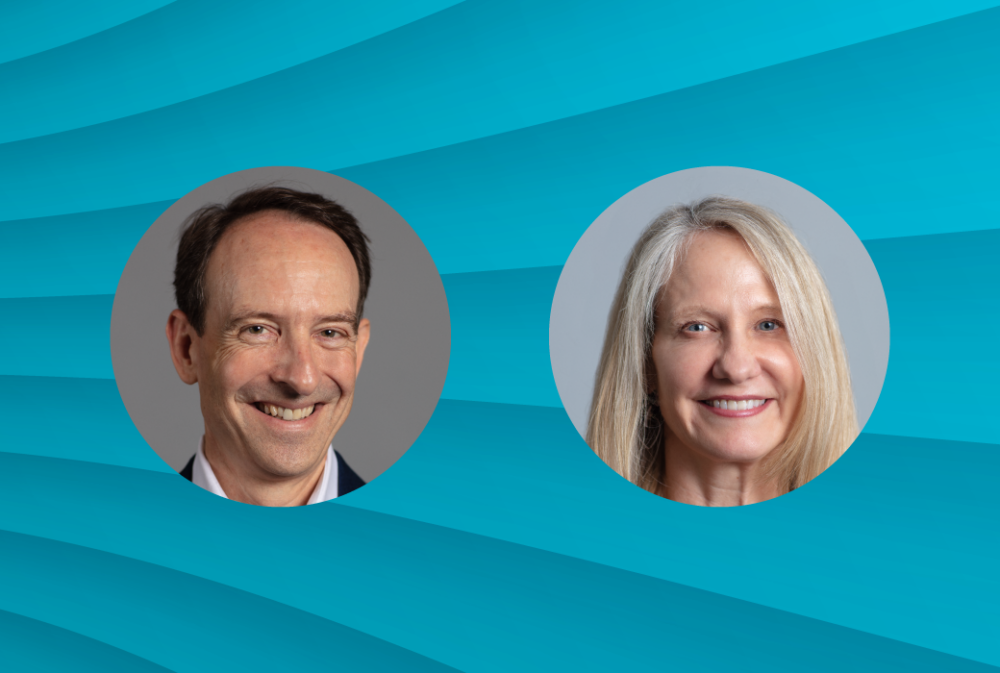

Impact Investments, Impact Investing Advisory Services
Stephen Vicinelli and Catherine Dun Rappaport joined Social Finance in late 2022. Both devote their time to unlocking the change-making potential of passive charitable capital, or assets that are indirectly invested through donor-advised funds (DAFs) or other financial vehicles with charitable intent.
Here, Vicinelli and Dun Rappaport discuss how Social Finance is working to harness the power of impact capital to create transformative opportunities for social, racial, and environmental justice.
Our efforts to mobilize passive charitable capital toward impact have evolved, especially over the last five years. What started as a project resourcing strategy—we’ve raised more than $28 million in DAF funding for various work over the years—is now a dedicated work stream that encompasses multiple large engagements. Can you explain why we’re focusing on mobilizing passive charitable capital? What’s the opportunity here?
Vicinelli: There’s roughly $230 billion in capital that has been, for all intents and purposes, given away to charitable causes. And, when you contribute charitable capital to something like a DAF, that transaction is irrevocable—you cannot take that money back. The challenge here is that there is no force or requirement to make that impact happen.
Shockingly, some donors either forget about the money they’ve parked in their DAFs or just don’t get around to directing it towards impact. And those funds might sit in money market accounts, or equity index funds, but only in rare instances are they generating positive impact.
One idea we have been working with is the concept of charitable dollar recycling. There’s a lot of money and a lot of need, and what we’re trying to do is lever these charitable funds out into impactful strategies. If you’re a DAF donor, you can direct your philanthropic capital to your alma mater or to your local food pantry, but that is a static gift that ends there. What if you could invest those dollars, via a recoverable grant, into a strategy that achieves measurable, positive outcomes? Then you are using your charitable capital in a catalytic way—you have invested in something regenerative and renewable rather than something static. And when the recoverable grant is returned, as intended, then you can do it all over again.
There’s a lot of money and a lot of need, and what we’re trying to do is lever these charitable funds out into impactful strategies.Stephen Vicinelli
Why is it so hard for donors seeking to catalyze measurable impact with their capital to actually achieve that?
Vicinelli: What’s that aphorism? “The road to hell is paved with good intentions.” I think what I’m getting at is that people approach this work with good intentions but it’s difficult work. Assessing investments is really hard. Considering impact with rigor, credibility, and integrity, and then measuring it and reporting it with transparency is really, really hard.
When I was a kid, I was given a model airplane to build and I was so excited but then I realized that I didn’t have the necessary skills to assemble it and no one was going to help me. So then the plane just sat there. A lot of passive impact capital is in a similar state. There’s intention, but when you stand up and face the reality of the work required, it’s hard.
Dun Rappaport: I think one of the challenges is that impact measurement in impact investing is that the field is nascent, and we’re still in the process of figuring out best practices. There also aren’t too many organizations in the section of the Venn diagram where credible impact assessment and investment expertise overlap. There are research institutions that assess impact in traditional ways with tools like randomized control trials, and there are investment firms that prioritize all things financial. There just aren’t very many places where these two things come together.
But what keeps me up at night is when there are claims of absolute impact without anyone really looking under the hood, or, on the flip side, when impact assessment is so wonky and laborious that it clobbers business. There has to be a middle ground and finding that middle ground is hard. And there’s been appropriate skepticism of impact washing, which I welcome—it’s healthy. But we need to figure out how to maintain the rigor and integrity of impact assessment while mobilizing passive impact capital at scale.
We need to figure out how to maintain the rigor and integrity of impact assessment while mobilizing passive impact capital at scale.Catherine Dun Rappaport
Your teams are in the process of launching multiple solutions designed to address this opportunity, including recoverable grant initiatives in partnerships with community foundations and DAF sponsors as well as an impact-first fund. Could you talk about both of these pieces of work and the ideas driving them?
Vicinelli: These partnerships represent the two different solutions we propose for mobilizing passive charitable capital. One is more bespoke and one is more ready-made.
With our recoverable grant work, which we’ve done with The Boston Foundation, Jewish Community Federation and Endowment Fund, and the Silicon Valley Community Foundation, we engage donors and highlight impact-first investment opportunities that might meet their donors’ goals. It’s really about engaging with donors and understanding what they are looking for through focus groups and interviews. A lot of these opportunities are place-based—depending on the location of the organization—or values-aligned. For example, many donors at The Boston Foundation are interested in opportunities that connect to local issues in the Greater Boston area.
The impact-first fund will operate at a larger scale and I think it’s really where Social Finance brings its years of experience with innovative financing structures to bear. The Fund will be a one-stop-shop solution for impact-first investors who seek ease of access, integrity of impact, and full transparency in a cost-effective structure. Here, we will commingle capital from donors and investors alike and allocate that capital on behalf of investors based on their interests and impact goals, while also handling all of the diligence, administrative, and reporting work.
Catherine, could you speak to this work from an impact perspective?
Dun Rappaport: Well, with the impact-first fund, to address a variety of large, complex problems, ranging from economic inequality to climate change. With this approach we’re also trying to solve for the fact that credible, impact-centered and achieving impact investing opportunities can be difficult for investors to access. On top of that, we’re intentionally investing in fund managers led by people of color, women, and other historically marginalized groups, and funds focused on supporting marginalized and underrepresented communities. We hold ourselves and the funds we invest in accountable for achieving goals related to all of these things and have a range of related indicators and measures that we track. We also intentionally try to support underlying funds as they try to assess and improve impact. This is to ensure that our impact measurement and reporting processes are feasible and support funds and fund managers.
You just referenced our impact thesis. What does that thesis look like when practically applied in the context of a deal?
Dun Rappaport: It’s actually a pretty fun and challenging balancing act, and it’s definitely an exercise in humility. We need to center rigor and integrity in our work and collect enough information to understand how we, our underlying funds, and the enterprises they support achieve impact. We also need to be honest and realistic about what actually can be known and assessed when we’re in a position to make financing decisions. Finally, it’s also extremely important for us not to overwhelm impact-focused funds with cumbersome and burdensome data requests that might hamstring their ability to actually do the work that delivers targeted impact.
So, our impact thesis has five key goals:
- meeting donor need for a one-stop shop they can trust to source and finance viable investments that deliver positive social and environmental impacts;
- catalyzing investment in impact-delivering funds and enterprises;
- supporting historically marginalized fund managers and communities;
- building the impact-first field;
- and probably most importantly, supporting funds and enterprises that actually deliver meaningful, positive impact.
Applying this thesis to our work means having clear systems in place to collect impact data, use those data to inform decision making, and enhance and evolve the work as we learn about the impacts we achieve or don’t achieve. This thesis and related processes inform every aspect of the work we do: sourcing funds, conducting impact diligence before investing in funds, negotiating reporting requirements, conducting on-going impact measurement and management, and even exiting funds.
Here’s an example:
We’re currently elbow-deep in negotiations with an impact-first fund that’s focused on addressing the wealth gap, and especially the racial wealth gap, by helping homeowners refinance predatory home loans. This fund has a track record for doing this work on a relatively small scale and is ready to expand dramatically. It’s also led by and employs a large percentage of people of color.
Clearly, the Fund’s work is very much aligned with our impact goals, which is why it made it into our pipeline. After realizing this fit, we conducted an extensive impact diligence process where we assessed its potential impact and our contribution to that impact using an impact framework informed by the Impact Management Project’s Five Dimensions of Impact. We considered our investment contribution; who the fund serves; the type, depth, reach, and scale of its likely impact; potential impact risks associated with its work; and how likely the fund would be able to attract the capital it needs to achieve impact without our investment. We also reviewed the systems that the fund has in place to collect and use viable impact data and the business and environmental practices of the fund itself.
As my team conducted this kind of impact diligence, other Social Finance team members conducted deep financial diligence. We do these things simultaneously, because funds need to meet our standards for both impact and financial strength for us to invest in them. Also, and it’s important to mention this, as we do the work, we look to assess funds’ connections to the communities they intend to serve and commitment to partnering with those communities effectively. We also look to be good partners ourselves by asking questions about how we can make the work we’re doing useful and practical to the funds.
If we move forward with this particular investment, the next phase of our work will be negotiating reporting requirements that are feasible and not burdensome to the fund, and provide credible impact evidence. We’ll review that reporting at a regular cadence, and, as needed, evolve our lending practices based on what we learn. We’ll also partner with the fund at exit to ensure that we and they take steps to ensure continued positive impact even at exit.
Where do you see this work in five years?
Dun Rappaport: My dream for this is for Social Finance’s work to help drive billions of dollars toward impact-first investments that measurably and legitimately improve outcomes for people and communities. I’d feel deeply satisfied if I could know that, through this work, Social Finance helped move billions of capital towards making a real, positive difference. I’d also like for the ground-breaking work we’re doing in credible impact measurement to turn the tide on the puffery and green- and impact-washing that’s all too prevalent in space.
Vicinelli: We want the newspaper headline to read: “How the Impact-First Fund Took Impact Investing Mainstream.”
Learn more about our work with DAFs and charitable assets →
Related Insight

Increasing Your Impact by Blurring the Lines between Investing and Philanthropy
Social Finance Board Member Laura Lauder and her husband, Gary, reflect on their innovative approach to integrating impact across a portfolio.